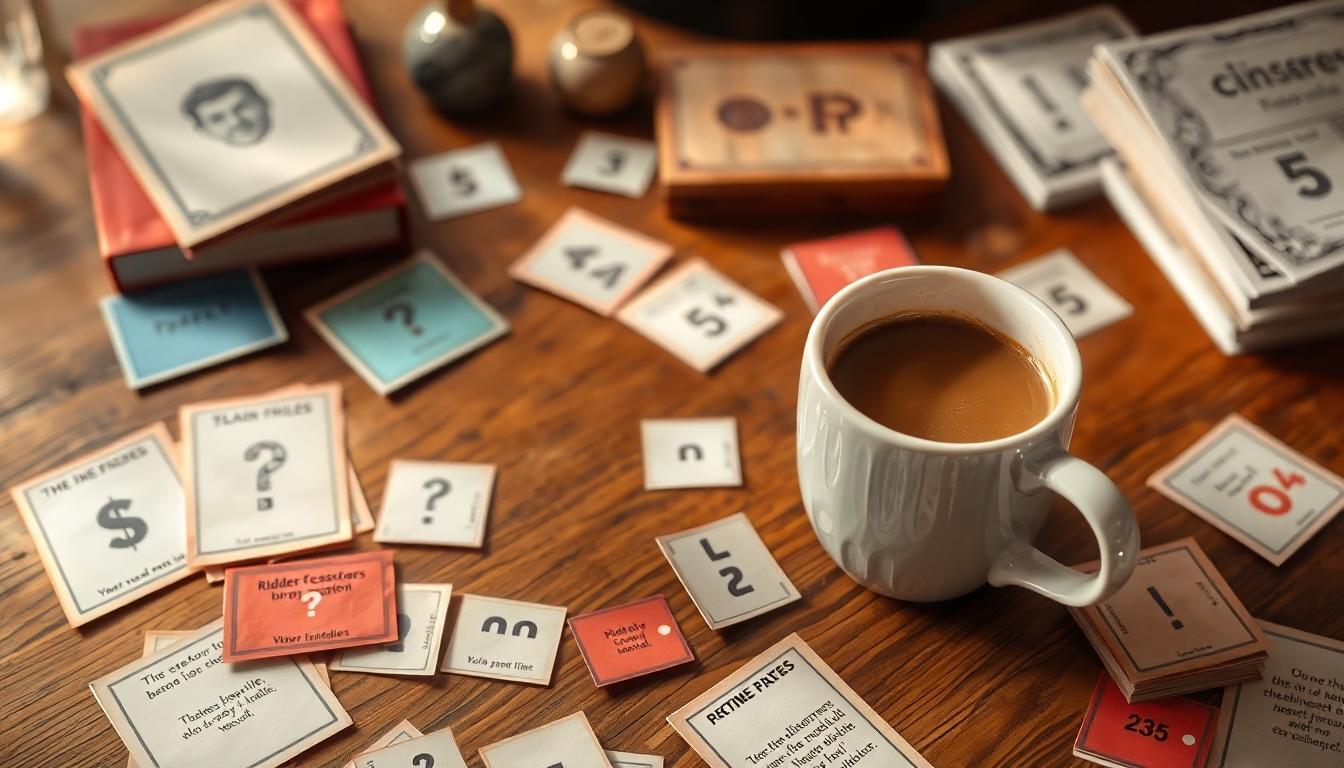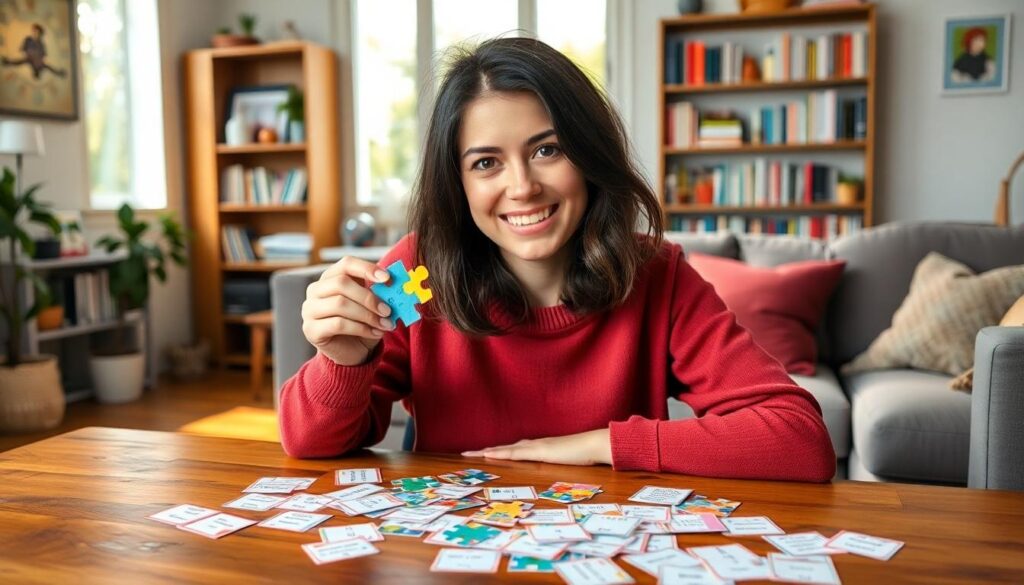Looking for a brain workout that’s not too easy but not impossibly hard? Medium riddles strike the perfect balance between challenge and solvability. They’ll push your cognitive abilities just enough to make solving them feel rewarding without leaving you frustrated.
What Makes a Riddle “Medium” Difficulty?
Medium difficulty riddles strike the perfect balance between elementary brain teasers and impossibly complex puzzles. Their sweet spot of challenge makes them accessible yet rewarding for most puzzle enthusiasts. But what exactly qualifies a riddle as “medium” difficulty?
Several key elements determine a riddle’s difficulty level. Most medium riddles require some logical deduction without demanding specialized knowledge. They typically contain enough clues to guide solvers toward the answer without making it immediately obvious.
Wordplay features prominently in medium riddles, often using puns, metaphors, or double meanings that require careful analysis. These linguistic devices add complexity without making the puzzle unsolvable. Medium riddles also usually have answers that feel satisfying when discovered—creating that “aha!” moment when the answer clicks.
The cognitive leap needed to solve medium riddles is substantial but not overwhelming. They may require considering multiple interpretations or thinking outside conventional patterns. Many medium-level riddles rely on common knowledge rather than obscure facts, making them accessible to a wider audience.
Time investment serves as another indicator of medium difficulty. These riddles typically take minutes to solve—not seconds (like easy riddles) or hours (like the most difficult ones). They’re challenging enough to engage your brain but not so difficult that you’ll give up in frustration.
10 Classic Medium Riddles That Challenge Your Thinking

- What Has Keys But Can’t Open Locks?
A keyboard has plenty of keys, but you’ll never unlock a door with it. This classic riddle plays on the dual meaning of “keys,” making it a perfect example of how medium riddles challenge our thinking by forcing us to consider alternative interpretations.
- What Is Always Coming But Never Arrives?
Tomorrow is perpetually on the horizon but remains forever out of reach. This philosophical riddle makes us pause and consider the concept of time, demonstrating how medium riddles often incorporate abstract concepts.
- What Can You Catch But Not Throw?
A cold is something we catch involuntarily but can never toss to others (at least not intentionally). The clever wordplay here forces us to think beyond the literal meaning of “catch” and “throw.”
- What Has Many Teeth But Cannot Bite?
A comb features many teeth but lacks any biting ability. This riddle illustrates how everyday objects can be described in unexpected ways, challenging our conventional thinking patterns.
- What Is Full of Holes But Still Holds Water?
A sponge contradicts our expectations by being both hole-filled and water-retaining. This paradoxical riddle requires us to reconcile seemingly contradictory properties.
- What Thrives When You Feed It But Dies When You Water It?
Fire grows stronger with fuel but is extinguished by water. This natural element riddle uses contrasting actions to create a mental puzzle that tests our knowledge of basic science.
- What Becomes Wetter the More It Dries?
A towel gets increasingly damp as it performs its drying function. The apparent contradiction in this riddle challenges our usual way of thinking about cause and effect.
- What Is Black and White and Blue?
A sad zebra combines literal physical characteristics with an emotional state. This riddle cleverly mixes concrete and abstract concepts, demonstrating the playful nature of medium riddles.
- What Has Thirteen Hearts But No Other Organs?
A deck of cards contains thirteen heart cards but no actual bodily organs. This riddle requires familiarity with common objects and their properties, showing how medium riddles often draw on general knowledge.
- What Is Easy to Get Into But Hard to Get Out Of?
Trouble comes to us easily but often proves difficult to escape. This simple yet profound riddle speaks to universal human experience, showing how medium riddles can be both accessible and thought-provoking.
Word Play Riddles
Word play riddles use linguistic tricks and double meanings to create their challenges. For instance, “What can you hold in your right hand but never in your left?” stumps many people until they realize the answer is simply “your left hand.” These riddles exploit ambiguities in language, forcing us to examine our assumptions about how words relate to objects and concepts.
Logic-Based Brain Teasers
Logic-based brain teasers require careful reasoning rather than linguistic cleverness. Consider this classic: “Two fathers and two sons are in a car, yet there are only three people. How is this possible?” The answer lies in understanding relationships—they are a grandfather, a father, and a son. The middle person is both a father to the youngest and a son to the oldest. These teasers challenge our ability to solve problems by applying logical principles to unusual scenarios.
7 Medium Riddles With Surprising Answers

Ready to challenge your brain with some clever wordplay and logical thinking? These medium-difficulty riddles offer the perfect balance of challenge and satisfaction when solved.
- What has 88 keys but cannot open a door? A piano has many keys for creating music, but none that will unlock anything.
- What is as light as a feather but the strongest man cannot hold long? Your breath might seem weightless, but even the strongest person can’t hold it indefinitely.
- What has branches but no fruit, trunk, or leaves? A bank features many branches across different locations without any botanical features.
- What thrives when fed but dies when watered? Fire grows stronger when fed with fuel but is extinguished immediately when doused with water.
- What has a bottom at the top? Legs have their bottom portions positioned at the top where they connect to your body.
- What can you catch but never throw? A cold can be caught when you’re exposed to viruses, but it’s impossible to throw one to someone else directly.
- Two fathers and two sons in a car—three people total. How? The answer lies in their relationship: a grandfather, his son, and his grandson represent three people total while fulfilling the roles of two fathers and two sons.
Mathematical Medium Riddles
Mathematical riddles rely on numerical patterns and logical reasoning rather than wordplay alone. For instance, “What do 11, 69, and 88 have in common?” stumps many until they realize these numbers read exactly the same upside-down. These puzzles often require you to think beyond standard arithmetic operations and consider alternative ways of viewing numbers. Another example involves fruit wordplay: “I am a fruit and a shape. Two of me sound identical. Rearranged, I’m a crime.” The answer is “pear,” which when rearranged becomes “reap” (to steal or take unlawfully).
Pattern Recognition Puzzles
Pattern recognition riddles challenge our ability to identify sequences, visual relationships, or linguistic connections. Consider the puzzle about rearranging letters to form a crime—taking “pear” and rearranging it to spell “reap” (as in “to reap what you didn’t sow”). Another example states: “A one-story yellow house has no stairs.” While many people search for a trick, the answer simply acknowledges reality—a single-story building doesn’t need stairs. These puzzles train our minds to look beyond the obvious and recognize underlying patterns that might not be immediately apparent.
Medium Riddles That Use Lateral Thinking Skills

Lateral thinking riddles challenge us to step outside conventional reasoning patterns and approach problems from unexpected angles. Unlike vertical thinking puzzles that follow a linear logical path, these brain teasers require creative problem-solving skills and mental flexibility. We’ve compiled some fascinating medium riddles that showcase the power of lateral thinking and help sharpen your cognitive abilities.
The Lightbulb Switch Challenge
One classic lateral thinking puzzle involves three switches in a basement that control a single lightbulb in an attic. You must determine which switch controls the bulb, but you can only go upstairs once. The solution relies on using heat as an indicator – turn one switch on for several minutes, then off, turn another on, and go upstairs. The bulb that’s on connects to your second switch, while a warm (but off) bulb connects to the first switch, and a cold, off bulb connects to the third.
The Hiccup Cure Conundrum
This riddle presents an unusual scenario: a man enters a bar and asks for water, but instead of serving him, the bartender points a gun at him. Rather than being alarmed, the man thanks the bartender and leaves. What happened? The lateral solution reveals the man had hiccups, and the sudden fear from seeing the gun cured his condition immediately – demonstrating how context completely transforms the situation.
The Lilypad Growth Puzzle
A seemingly simple math problem reveals powerful lateral thinking: if a lilypad doubles in size each day and completely covers a pond on day 20, on which day was it half-covered? Many people incorrectly answer day 10, but the correct answer is day 19. This riddle demonstrates exponential growth concepts and requires us to work backward from the final condition rather than thinking linearly.
The Coal, Carrot, and Scarf Mystery
Picture this scenario: you discover coal, a carrot, and a scarf scattered on a lawn. These items appear random until you apply lateral thinking to connect them as components of a melted snowman. This puzzle challenges us to identify relationships between seemingly unrelated objects by reframing the context entirely.
The Wordplay Transformation
Many medium lateral riddles involve clever wordplay, such as adding or changing letters. For example, adding the letter “G” to “one” creates “gone” – transforming presence into absence. These puzzles force us to consider how small changes can completely alter meaning, exercising our linguistic flexibility and pattern recognition simultaneously.
Practicing these lateral thinking riddles enhances problem-solving abilities applicable to real-industry situations. They train our brains to recognize alternative perspectives, question assumptions, and develop creative answers to challenges. The cognitive flexibility developed through solving these puzzles helps us approach problems from multiple angles rather than getting stuck in conventional thinking patterns.
Family-Friendly Medium Riddles for Game Night

Medium riddles offer the perfect balance of challenge and accessibility for family game nights, making them ideal entertainment for all ages. These carefully calibrated puzzles create opportunities for everyone to participate while stimulating critical thinking skills. We’ve collected our favorite family-friendly medium riddles across four distinct categories to spice up your next gathering.
Wordplay Riddles
Wordplay riddles leverage language tricks to create captivating challenges that build vocabulary skills:
- The Shrinking Word: What five-letter word actually becomes shorter when you add two letters to it? The answer is “short” – add “er” and it literally becomes “shorter” while referring to something with less length.
- The Mysterious Object: I have keys but no locks, space but no room, and you can enter but never go outside. What am I? It’s a keyboard! This riddle cleverly plays with familiar concepts in unexpected contexts.
Logic-Based Puzzles
Logic riddles encourage analytical thinking and challenge assumptions:
- The Doctor’s Surprise: A doctor rushes into an emergency room, sees a car accident victim, and exclaims, “That’s my son!” But the doctor isn’t the father. How is this possible? The answer reveals our unconscious biases – the doctor is the boy’s mother.
- The Family Puzzle: Mary has four daughters, and each daughter has a brother. How many children does Mary have in total? The answer is five children – four daughters who all share one brother.
Object-Based Challenges
Object riddles focus on identifying items based on partial descriptions:
- The Letter Pattern: What begins with the letter “T,” ends with the letter “T,” and has “T” inside it? A teapot fits this description perfectly with its beginning, ending, and contents.
- The Faceless Figure: I have a face and two hands but no arms or legs. What am I? A clock displays these characteristics while being something entirely different from a person.
Creative Conundrums
These riddles require innovative thinking and perspective shifts:
- The Industry Traveler: I fly worldwide but never leave my corner. What am I? A postage stamp journeys globally while staying affixed to an envelope corner.
- The Upside-Down Object: What has a bottom at the top? Your legs when sitting – this riddle cleverly plays with positioning and perspective.
For maximum enjoyment, incorporate these riddles into game night with a simple hint system or friendly timer. Teams can take turns solving puzzles, fostering both competition and collaboration. These medium-difficulty riddles promote lateral thinking and vocabulary development while creating memorable family moments around the table.
How to Solve Medium Riddles: Tips and Techniques

Medium riddles strike the perfect balance between accessibility and challenge, requiring both critical thinking and creative problem-solving approaches. We’ve compiled these evidence-based strategies to help you crack even the most perplexing medium-difficulty riddles.
Look for Wordplay and Double Meanings
Wordplay forms the foundation of many medium riddles. Pay close attention to puns, homophones, and letter manipulation that might reveal hidden meanings. For instance, when faced with “What’s at the end of a rainbow?” the answer isn’t a pot of gold but rather the letter “W” (the last letter in “rainbow”). Always consider both literal and figurative interpretations of words to uncover clever linguistic tricks.
Challenge Your Assumptions
Medium riddles often deliberately mislead by exploiting common assumptions. When you encounter a riddle about a “one-story blue house,” don’t automatically picture architectural features—the absence of stairs is actually key to the solution. Questioning your initial interpretations helps avoid the mental traps these riddles set for unwary solvers.
Employ Lateral Thinking
Traditional logic sometimes falls short when solving medium riddles. Lateral thinking involves approaching problems from unexpected angles and reinterpreting the context. A riddle about a “taxi driver” walking the wrong way might seem contradictory until you realize the person isn’t actively driving but walking on foot. This mental flexibility allows you to see beyond conventional reasoning patterns.
Distinguish Between Literal and Metaphorical Meanings
Many medium riddles play with the tension between literal objects and abstract concepts. When you encounter “What must be broken before you can use it?” consider physical objects that literally require breaking (like an egg) rather than immediately searching for metaphorical meanings. Balancing both interpretations leads to breakthrough moments in riddle-solving.
Use Process of Elimination
Systematic analysis helps tackle relationship-based riddles. For puzzles like “How is D related to A?” (where A is D’s aunt), methodically examine each possible family connection until finding the logical answer. This structured approach narrows possibilities and prevents wild guesses.
Recognize Common Themes
Certain concepts appear frequently in medium riddles. Temporal elements (like “tomorrow” as an answer to existential questions), paradoxes, and everyday objects with hidden properties (elevators, sponges) constitute recurring themes. Recognizing these patterns helps you anticipate potential answers.
Practice Pattern Recognition
Improve your skills by solving category-exact riddles that focus on particular types of reasoning. Logic-based puzzles strengthen deductive reasoning, while wordplay riddles enhance linguistic awareness. Regular practice with diverse riddle styles builds the mental flexibility needed to tackle unknown challenges.
Verify Multiple Interpretations
Before settling on an answer, test several possible answers against the riddle’s wording. Many medium riddles deliberately exploit ambiguity, making verification crucial. Check whether your solution satisfies all parts of the riddle, especially in multi-part challenges that incorporate sequential reasoning or word transformations.
Break Down Complex Riddles into Components
When facing longer riddles, analyze each section independently before synthesizing the complete solution. Some riddles involve sequential transformations (like “Startling → Starling → Staring → String → Sting → Sing → Sin → In → I”) that require methodical deconstruction. Dividing complex puzzles into manageable parts prevents overwhelming your analytical capacity.
Create Your Own Medium Riddles: A Step-by-Step Guide

Crafting your own medium riddles can be a rewarding creative exercise that challenges both the creator and the solver. We’ve compiled a straightforward process to help you develop riddles that strike the perfect balance between too easy and too difficult.
Step 1: Choose Your Subject Matter
Select a familiar object or concept as your answer. The best medium riddles often revolve around everyday items that people recognize but might not immediately think of when given indirect clues. Common objects like coins, clocks, or natural elements make excellent subjects for medium-difficulty riddles.
Step 2: Identify Unique Characteristics
List all distinctive features of your chosen subject. Focus on attributes that could be described in multiple ways or that share characteristics with other objects. For example, a coin has a head and tail but no body—this unusual combination creates the perfect foundation for a riddle.
Step 3: Employ Strategic Wordplay
Incorporate puns, homophones, or double meanings into your riddle. Wordplay serves as the cornerstone of captivating medium riddles, creating that “aha moment” when solvers finally grasp the connection. Try using words with multiple definitions to create clever misdirection in your descriptions.
Step 4: Create Purposeful Misdirection
Guide your solver with clues that appear to lead in one direction but actually point elsewhere. Effective misdirection makes medium riddles challenging without becoming frustrating. Your goal is to make solvers think they understand what you’re describing before realizing there’s another interpretation entirely.
Step 5: Structure Your Riddle
Formulate your riddle using clear, concise language. Most effective medium riddles contain just one or two sentences that pack multiple layers of meaning. Keep your wording simple while ensuring the puzzle element remains intact.
Step 6: Test and Refine
Share your riddle with friends or family to gauge its difficulty level. Pay attention to their thought process as they attempt to solve it. Their feedback will help you determine if your riddle falls within the “medium” range or needs adjustment to hit that sweet spot between too obvious and too obscure.
Examples to Inspire Your Creations
Consider this classic medium riddle: “I have a head, a tail, but no body. What am I?” The answer—a coin—demonstrates how effective medium riddles use familiar objects described in unusual ways.
Another example shows how misdirection works: “The more you take, the more you leave behind. What am I?” The answer—footsteps—illustrates how medium riddles can use actions rather than objects as their answers.
Benefits of Creating Your Own Riddles
Developing your own riddles enhances creativity and linguistic skills. The process forces you to examine objects from multiple perspectives and think about language in new ways. Also, sharing your original riddles provides a unique form of entertainment that can strengthen social connections and cognitive abilities among those who attempt to solve them.
By following these steps, you’ll create medium riddles that challenge and entertain while providing that satisfying moment of realization when the answer becomes clear. The perfect medium riddle leaves solvers feeling clever for figuring it out rather than frustrated by obscure references or disappointed by obvious answers.
The Benefits of Solving Medium Riddles Regularly

Cognitive Skill Development
Medium riddles offer substantial benefits for brain function by improving abstract thinking capabilities. Research shows these puzzles train our minds to interpret non-literal language and identify subtle patterns that might otherwise go unnoticed. The complexity of medium-difficulty riddles perfectly bridges the gap between basic comprehension and advanced problem-solving tasks. Critical thinking skills flourish when we regularly engage with these types of riddles, as our brains learn to systematically analyze clues and eliminate illogical answers. Short-term memory capacity also improves significantly, as solving medium riddles requires holding multiple variables in mind simultaneously throughout the problem-solving process.
Educational Advantages
Children experience remarkable vocabulary expansion when regularly exposed to medium riddles that contain nuanced language and clever wordplay. The collaborative aspect of riddle-solving creates opportunities for social skill development as kids share reasoning processes and work together toward answers. Adults benefit from enhanced concentration abilities, as decoding layered clues demands sustained mental focus. Teachers at the Stein Education Center have emphasized how medium riddles teach valuable problem-solving frameworks that students can apply to real-industry scenarios beyond puzzle activities.
Mental Health Benefits
Captivating with medium-intensity puzzles provides effective stress relief by diverting our attention away from daily pressures. The immersive nature of riddle-solving creates a mental break from anxiety-producing thoughts. Regular participation in these mentally stimulating activities is linked to reduced cognitive decline risks as we age. Neural plasticity—the brain’s ability to form new connections—is maintained through consistent mental challenges, potentially delaying dementia-related symptoms according to recent studies.
Skill Progression
Medium-level riddles function as excellent transitional tools between simple and complex reasoning tasks. These puzzles allow learners to advance from basic memory-based challenges to sophisticated logical thinking without experiencing the frustration that might come with overly difficult puzzles. Confidence building occurs naturally as individuals successfully navigate increasingly challenging riddles. The incremental difficulty supports sustained interest in cognitive exercises, creating a positive feedback loop of engagement and improvement.
Cross-Generational Applicability
Medium riddles demonstrate remarkable versatility across all age groups, making them ideal for family activities. While children develop foundational thinking skills through these puzzles, adults and seniors use them to preserve mental sharpness and cognitive function. Grandparents and grandchildren can enjoy these riddles together, creating meaningful intergenerational connections while simultaneously exercising their brains. The accessibility of medium-difficulty riddles makes them perfect for inclusion in family game nights, educational settings, and senior activity programs alike.
Where to Find More Medium Riddles Online

Looking for more mind-bending medium riddles to challenge yourself? We’ve compiled a list of the best online resources where you can discover hundreds of quality medium riddles with answers. These websites offer extensive collections that are perfect for puzzle enthusiasts seeking that sweet spot between too easy and too difficult.
- Riddles.com – This comprehensive platform features an impressive collection of medium riddles, including a dedicated section with 100 medium-level brain teasers. Each riddle comes complete with answers, making it easy to check your answers after you’ve given them your best attempt.
- Riddles Academy – With over 138 medium riddles specifically designed to challenge and entertain, this site offers one of the largest collections available online. Their riddles strike the perfect balance between accessibility and difficulty, providing captivating content for puzzle solvers of all experience levels.
- Riddle King – This user-friendly website organizes its medium-level riddles into clear categories, allowing you to browse based on your exact interests or preferences. Their thoughtful categorization system makes finding exactly the type of medium riddle you’re looking for quick and simple.
- Brainzilla – Offering exceptional variety, Brainzilla features many types of medium riddles including “What am I?” puzzles, mathematical challenges, tricky wordplay, funny conundrums, and logic-based brain teasers. They also provide convenient printable PDF downloads, perfect for offline solving or sharing with friends and family.
These online resources provide endless opportunities to test your problem-solving skills and enjoy the satisfaction of cracking clever medium riddles. Each platform offers unique collections that will keep your mind sharp and entertained for hours.
Conclusion
Medium riddles provide the perfect balance between challenge and accessibility creating an captivating mental workout for puzzle enthusiasts of all ages. They sharpen cognitive skills while delivering that satisfying “aha!” moment we all crave.
Whether you’re exploring wordplay puzzles playing with mathematical patterns or tackling lateral thinking challenges these brain teasers offer diverse paths to strengthen problem-solving abilities. We’ve seen how they can transform family gatherings enhance educational experiences and even support mental health.
By incorporating the solving strategies we’ve shared or trying your hand at creating original riddles you’ll discover endless opportunities for cognitive growth and entertainment. The resources we’ve provided will keep your mind active and engaged whenever you’re ready for your next riddle adventure.
Frequently Asked Questions
What makes a riddle “medium difficulty”?
Medium difficulty riddles strike a perfect balance between simple brain teasers and complex puzzles. They typically require logical deduction and some wordplay, but rely on common knowledge rather than obscure facts. These riddles need a moderate time investment to solve—engaging enough to provide a mental challenge without causing frustration. They’re accessible to most puzzle enthusiasts while still offering a satisfying “aha” moment.
How do wordplay riddles differ from logic-based riddles?
Wordplay riddles exploit linguistic ambiguities, double meanings, and homonyms to create clever misdirection. For example, “What has keys but can’t open locks?” (a piano). Logic-based riddles, however, require careful reasoning about relationships between concepts or objects to reach a solution. Both types stimulate different cognitive skills, with wordplay focusing on language processing and logic riddles emphasizing deductive reasoning.
What are lateral thinking riddles?
Lateral thinking riddles challenge conventional reasoning patterns by requiring solvers to approach problems from unexpected angles. These puzzles often have solutions that seem obvious after discovery but require creative thinking to reach. Examples include the Lightbulb Switch Challenge or the Lilypad Growth Puzzle. Lateral thinking riddles teach us to question assumptions and consider alternative perspectives—skills valuable in real-world problem-solving.
How can I improve my riddle-solving skills?
Improve riddle-solving by looking for wordplay and double meanings, challenging assumptions, and employing lateral thinking. Learn to distinguish between literal and metaphorical interpretations, use process of elimination, and recognize common riddle themes. Practice pattern recognition, verify multiple possible answers, and break complex riddles into smaller parts. Regular practice with diverse riddle types will significantly enhance your solving abilities.
Are medium riddles good for children?
Yes, medium riddles are excellent for children, especially those aged 8-12. They provide an appropriate challenge that builds critical thinking, vocabulary, and problem-solving skills without causing frustration. Family-friendly medium riddles can be incorporated into game nights to promote collaboration and memorable learning experiences. They serve as perfect transitional tools, helping children progress from simple to more complex reasoning tasks.
What cognitive benefits come from solving medium riddles?
Solving medium riddles enhances abstract thinking, improves vocabulary, strengthens concentration, and boosts memory retention. Regular engagement with these puzzles provides stress relief, builds cognitive reserves, and may reduce cognitive decline risks. Additionally, riddles improve pattern recognition, logical reasoning, and creative problem-solving—all valuable skills applicable in academic, professional, and everyday contexts.
How can I create my own medium riddles?
Create medium riddles by choosing familiar subjects, identifying unique characteristics, employing strategic wordplay, and crafting purposeful misdirection. Start with common objects or concepts that have distinctive features or multiple meanings. Incorporate analogies, metaphors, or puns to add complexity. Test your riddle on others to ensure it’s neither too obvious nor too obscure. This creative exercise enhances linguistic skills while providing entertainment value.
Where can I find more medium riddles online?
Find extensive collections of medium riddles on websites like Riddles.com, Riddles Academy, Riddle King, and Brainzilla. These platforms categorize riddles by difficulty and type, making navigation easy. Many sites offer daily riddles, themed collections, and user ratings. Some platforms include discussion sections where you can exchange solving strategies with fellow enthusiasts or submit your own original riddles.







